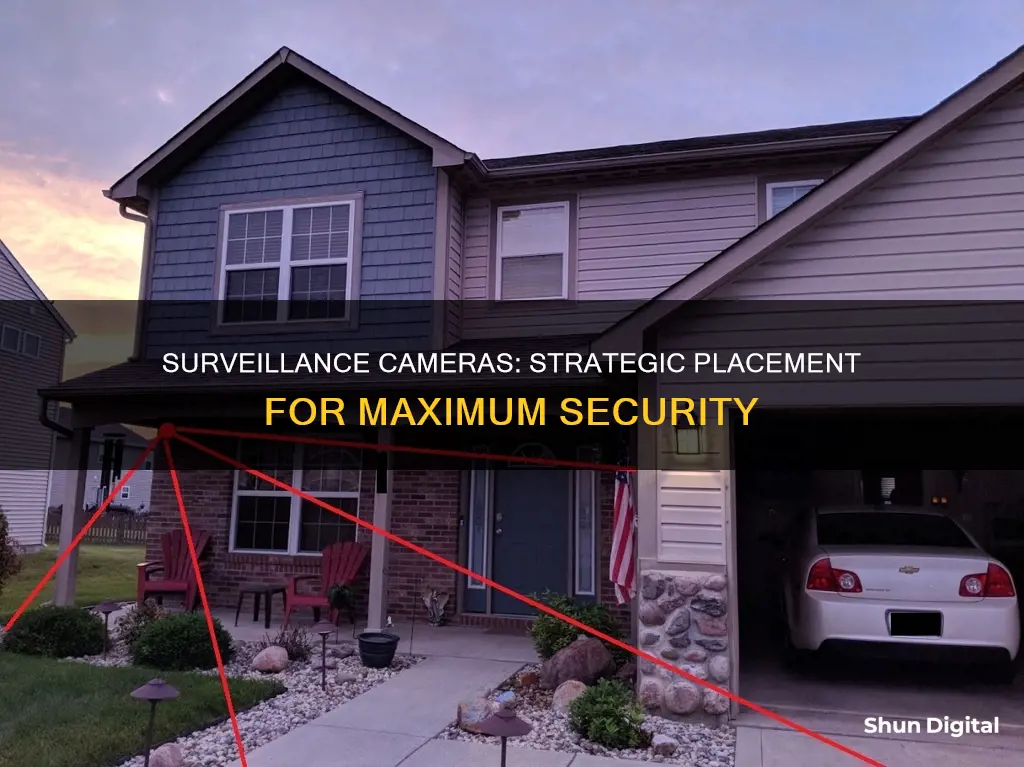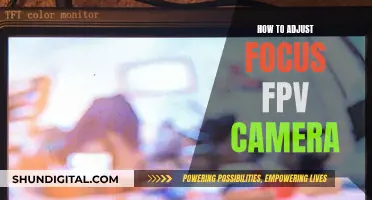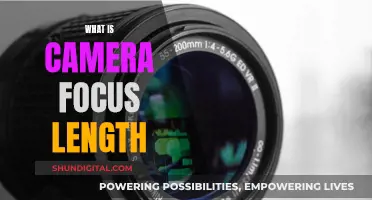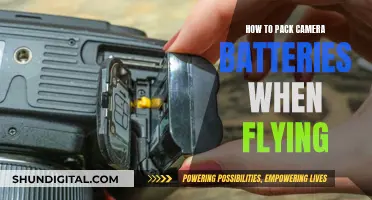
Surveillance cameras are a great way to beef up security at home or in the office. When deciding where to place them, it's important to consider the unique aspects of your property, including vulnerable areas, entry and exit points, and lighting. It's also essential to ensure that cameras are positioned correctly and securely to capture clear and well-lit footage that can help identify offenders. Here are some key considerations for optimal camera placement to maximise security.

Front, back, and side doors
Entry points are the first line of defence for your home, so placing cameras at main entrances and exits will help deter someone who might be considering breaking in. Over one-third of burglars enter through a front or back door, and 22% of burglars enter through the back door.
Where to place cameras by the front, back, and side doors
Place exterior cameras above or near any doors leading into your home. The best way to place your camera is about 7-10ft up (no less), and pointing down at an angle. This is the ideal position to record facial images. If you only have one level, you could enclose your front door security camera in mesh wiring to protect it from tampering.
If the front door isn't an option, the burglar will either move on or try their luck at a side door. If there is no side door, they will head straight to the back of the house. If there is a window adjacent to the door, position the camera so that it covers both. If that's a bit awkward, then have one covering the back door and another at the window. Make sure the camera systems you choose are fully weatherproof and can resist all kinds of outdoor conditions.
Other considerations
Consider the visibility of your cameras. Visible cameras may act as deterrents, while hidden cameras offer a tactical advantage. You could also consider enclosing your camera in mesh wiring to protect it from tampering.
Make sure your cameras are installed securely and are out of reach so they can't be easily knocked down or destroyed.
Soft Focus Shooting with Fuji: A Guide
You may want to see also

Off-street windows
Placement of Cameras Near Off-Street Windows
- It is recommended to install exterior cameras above off-street windows. Mounting cameras at a height of about nine feet above the ground can effectively deter potential vandalism and ensure the cameras are out of reach.
- If installing exterior cameras is not feasible, consider using interior cameras that face the off-street windows. Ensure the cameras are placed near the ceiling and angled appropriately to capture the desired footage.
- When placing cameras near windows, be mindful of window glare and lighting conditions. Avoid positioning cameras towards direct sunlight or bright lights, as this can disrupt the picture quality.
- Consider the field of view and range of the cameras. Avoid placing cameras too close to off-street windows, as this may limit their effectiveness in capturing clear footage.
- If possible, test the cameras before finalizing their installation. Evaluate the camera's angle, height, and field of view to ensure optimal coverage of the off-street windows and surrounding areas.
Additional Considerations for Camera Placement
- When deciding on the placement of security cameras, it is essential to respect legal and privacy boundaries. Avoid pointing cameras at neighbouring properties or areas where individuals expect a high level of privacy, such as bedrooms and bathrooms.
- Evaluate your property's entry points, including doors and windows, and consider placing cameras to cover as many of these areas as possible.
- In addition to off-street windows, consider securing other vulnerable areas such as front and back doors, driveways, common areas, and stairways.
- Assess the durability of outdoor cameras, ensuring they are designed to withstand various weather conditions and equipped with features like weather-resistant casing.
- If you have wireless cameras, check the Wi-Fi signal strength around your property to ensure reliable connectivity for your cameras.
By following these guidelines and considering the specific needs of your property, you can effectively enhance the security of your off-street windows and overall home security system.
Fixing Blurry Selfies: Camera Focus Issues and Solutions
You may want to see also

Driveways
It is recommended that the camera is placed at least 8 feet above the ground to avoid tampering and to ensure the best coverage of the area. If you have a long driveway, you may want to consider a wireless security camera that doesn't rely on Wi-Fi. You should also ensure that your camera is durable and able to withstand harsh weather conditions.
In addition to the driveway, you should also consider placing cameras on the front door, back door, side doors, basement door, and garage. These are all common entry points for burglars, and by securing these areas, you can prevent about 80% of burglaries.
It is also important to note that security cameras should not be placed in bedrooms or bathrooms due to privacy concerns. Additionally, be mindful of your neighbour's privacy and avoid placing cameras that capture footage of their property.
Best Cameras for Adobe Raw Native Shooting
You may want to see also

Common areas
When placing security cameras in common areas, there are a few things to keep in mind. Firstly, try to position the cameras in a corner of the room opposite the entry point. This provides the best coverage and ensures that anyone attempting to tamper with the camera is recorded. Secondly, the ideal height for a camera is around 10 feet or higher. This keeps the camera out of reach and makes it more difficult for someone to disable or steal it.
Additionally, consider the lighting and glare when placing cameras in common areas. Avoid pointing cameras towards windows or exterior doors, as the bright light may limit the camera's view. Instead, position cameras away from direct sunlight and use cameras with High Dynamic Range (HDR) to minimise glare.
It is also important to ensure that your cameras are securely installed. While some cameras can be attached with adhesives, screwing them directly into the wall provides a more secure mounting option.
By following these guidelines, you can effectively place security cameras in common areas to enhance the overall security of your property.
Displaying Camera Raw Data: A Step-by-Step Guide
You may want to see also

Stairways
Surveillance Cameras in Stairways
Installing a security camera in every room is neither practical nor ethical. However, cameras in stairways can capture any movement inside the house. For instance, if an intruder tries to break into a bedroom or a bathroom, a camera in the stairway can help track their movements.
Placement
Place cameras high up in the stairway, preferably in a corner, to capture the full area. The best height for a camera is usually around 10 feet or higher. This is high enough to keep people from accessing the camera unless they have a ladder.
Angle
When angling the camera, consider what you want to be able to see. If you want a long, sweeping view down the stairway, the camera will need to be higher up. If you want to capture close-ups, a lower angle will be more suitable.
Visibility
There is some debate about whether it is preferable for cameras to be visible or hidden. Visible cameras may deter thieves, but they also suggest that there is something valuable to protect. A combination of both visible and hidden cameras might be a good balance.
Stairway Safety
Monitoring stairways can also help keep your family members safe. For example, if you have elderly loved ones living with you who have trouble with balance, you can be alerted if they have an accident on the stairs and respond right away.
School Bus Camera Tickets: Insurance Impact?
You may want to see also
Frequently asked questions
It is recommended to place cameras at the front, back, and side doors, as well as above off-street windows and the driveway. Common areas such as the living room and master bedroom should also be covered, as well as stairways.
Cameras should be placed high enough to avoid tampering but low enough to capture facial features. The recommended height is between 8 and 10 feet from the ground.
The debate on whether cameras should be visible or hidden is ongoing. Some argue that visible cameras act as deterrents, while others believe hidden cameras offer a tactical advantage. Consider your security goals and the potential impact on intruders.







